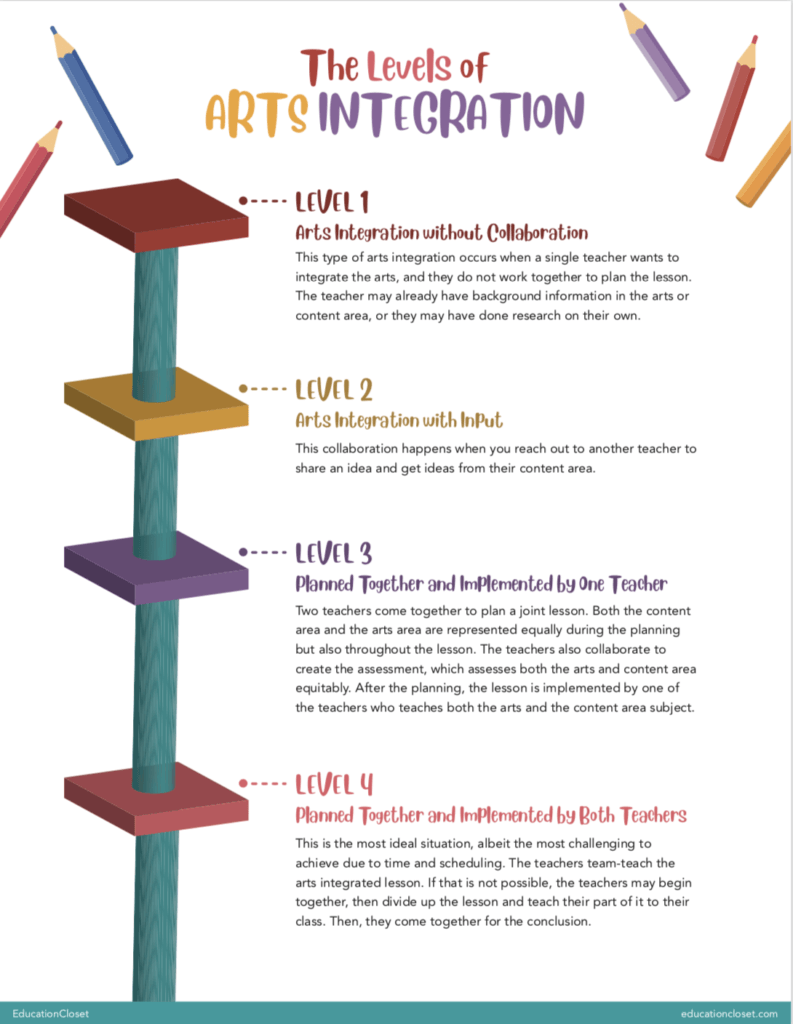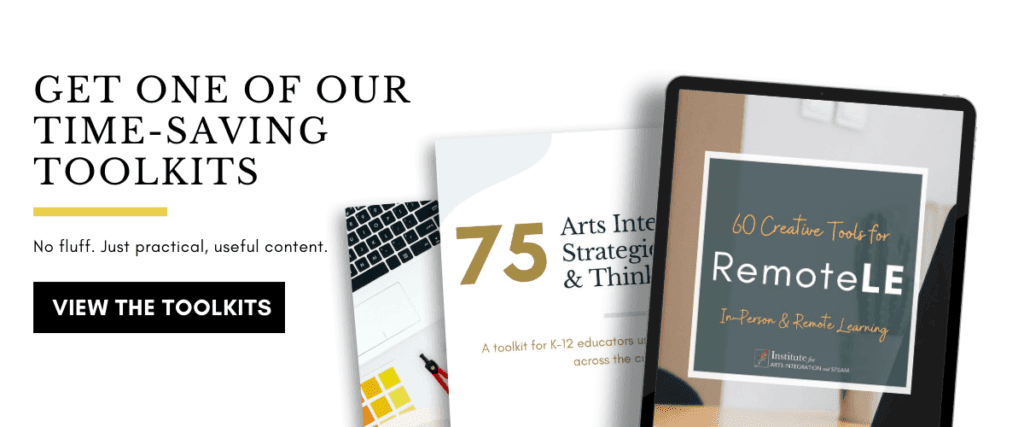Building Arts Integration Collaboration
6 Min Read • Arts Integration
“Innovation (and enjoyment) flourishes when teachers collaborate to learn and practice new strategies. Isolation is often the enemy of innovation.”
George Couros
A passionate, but rocky start
I remember when I first started dabbling in Arts Integration. I loved the idea of merging art with content and how much enjoyment I got out of teaching this way. And I loved how the engagement for students went through the roof with my arts-integrated lessons and projects. Other than the support from EducationCloset’s classes, which I sought out on my own, I was the only teacher I knew using this approach.
I reached out to my art teacher to collaborate. She was excited that I was incorporating her art techniques into my lessons. I shared a list of units that we study in 3rd grade. In return, she gave me many ideas of artists and projects that might connect to my topics. She actually shared way more ideas than I had time to use! I ended up only using one idea from the entire conversation.
How I wish I had known more about arts integration and collaboration at that point! I loved bouncing ideas off of her, and she taught me so much that I could use in my classroom. However, I missed the mark with the ideal way to collaborate on an arts integration lesson. You see, I accepted some ideas from her, but I did everything. I taught my content, and I taught the art to the best of my ability. Implementing and assessing? All me! I pulled the standards in after I found a thematic connection and after I created a project. There is a better way!
Collaboration is Key
Collaboration is an essential part of Arts Integration. It is best practice for educators regardless of the subject. It is crucial to innovation, and it is just as important for teacher well-being. While Arts Integration can happen in isolation, providing time and support for teachers to collaborate on lessons and units leads to a more authentic implementation of the approach.
In order to truly integrate the arts, the lesson or unit should contain arts standards and content standards that naturally align. Unlike my enthusiastic dabbling, we should start with the standards and design the learning experience based off of them.
We don’t expect arts teachers to be experts in all of the content standards. Similarly, we don’t expect content area teachers to be experts in all of the art standards. As teachers, we are responsible for understanding the standards we teach at a deep level. This ensures that our instruction matches the rigor and expectations as described for our grade level. When teachers plan arts-integrated lessons and units independently, it is much harder to find connecting and aligning standards. Why? Because we simply aren’t an expert in the other area!
Levels of Collaboration
Based on my experience, I have found there to be multiple levels of collaboration for arts integration. As my comfort level, experience, and knowledge of arts integration grew, I moved up the levels of collaboration step by step. Part of this was due to the fact that other teachers saw what was happening and wanted to learn too. Also, the more comfortable I became, the more I could educate my colleagues… which led to more collaborative projects.
Level 1: Arts Integration without Collaboration
This type of arts integration occurs when a single teacher wants to integrate the arts, and they do not work together to plan the lesson. The teacher may already have background information in the arts or content area, or they may have done research on their own.
While this is not ideal, it may be the only way if you are a content area teacher and don’t have arts specialists. If you find yourself in this situation, make sure to get connected with an online community. I recommend #K12Artchat on Twitter or the Arts Integration and STEAM Thinktank on Facebook.
Level 2: Arts Integration with Input
This collaboration happens when you reach out to another teacher to share an idea and get ideas from their content area. For example, my first year integrating the arts in my 3rd grade classroom, I knew that I wanted to integrate the arts as much as possible, but I wanted more ideas for ways to connect to visual arts. I emailed the art teacher in my building, and she responded with all of the connections that she found that could tie in with the topics I had shared.
This helped with my initial brainstorm, but in hindsight, it would have been better to connect standards instead of just topics. However, I was so enthusiastic about the approach that I was thinking in big, broad, projects instead of integrating skills and standards. My art teacher was so excited that someone asked about integrating art that she gave me tons of ideas. I used her ideas as inspiration when planning my lessons.
Level 3: Planned Together and Implemented by One Teacher
With this type of collaboration, two teachers come together to plan a joint lesson. Both the content area and the arts area are represented equally during the planning but also throughout the lesson. The teachers also collaborate to create the assessment, which assesses both the arts and content area equitably. After the planning, the lesson is implemented by one of the teachers who teaches both the arts and the content area subject.
Level 4: Planned Together and Implemented by Both Teachers
This is the most ideal situation, albeit the most challenging to achieve due to time and scheduling. The planning occurs just as it did in #3. However, the teachers team-teach the arts integrated lesson. If that is not possible, the teachers may begin together, then divide up the lesson and teach their part of it to their class. Then, they come together for the conclusion.
Takeaways
Notice how as the level of the collaboration rose, the authenticity of my integration improved? While it is not impossible to plan a wonderful arts integrated lesson based on input, the equity of the arts and content area really becomes apparent as we begin to collaborate and plan together.
At first, I was frustrated that no one else could collaborate with me, or that people didn’t want to collaborate. When colleagues and I were able to carve out time to sit down together, it wasn’t a magical experience of perfect, connecting ideas. I found that I wasn’t on the same page as my colleagues because what I thought of as an extension, they thought of as integration. Or they had no idea of how integration happens by connecting standards.
Over time, I was able to overcome these obstacles by sharing tidbits of knowledge during these collaborations. We didn’t always collaboratively plan, but I gained some ideas and was able to let my colleagues know what I had in mind for next time. I was also able to share information with our whole faculty during faculty meetings so that everyone would have basic knowledge of what it means to integrate.
In summary, collaboration is essential for planning arts integration lessons. We might not always be on the same page as our colleagues, which can be a barrier to collaboration. If we continue to share what we’re doing and reach out with specific questions, we will get closer and closer to our goal.
Resources:
How We Know that Collaboration Works





